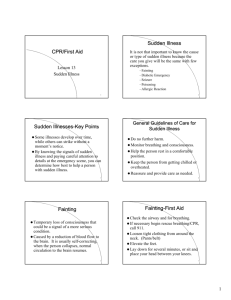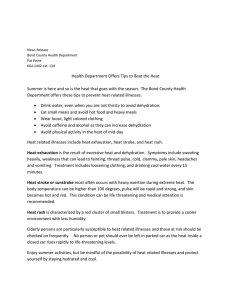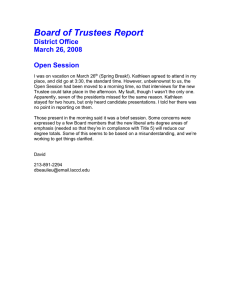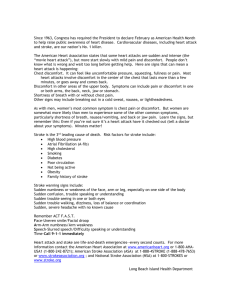Emergency Care ... - 1 - 1. ___________________________________________________________________________
advertisement
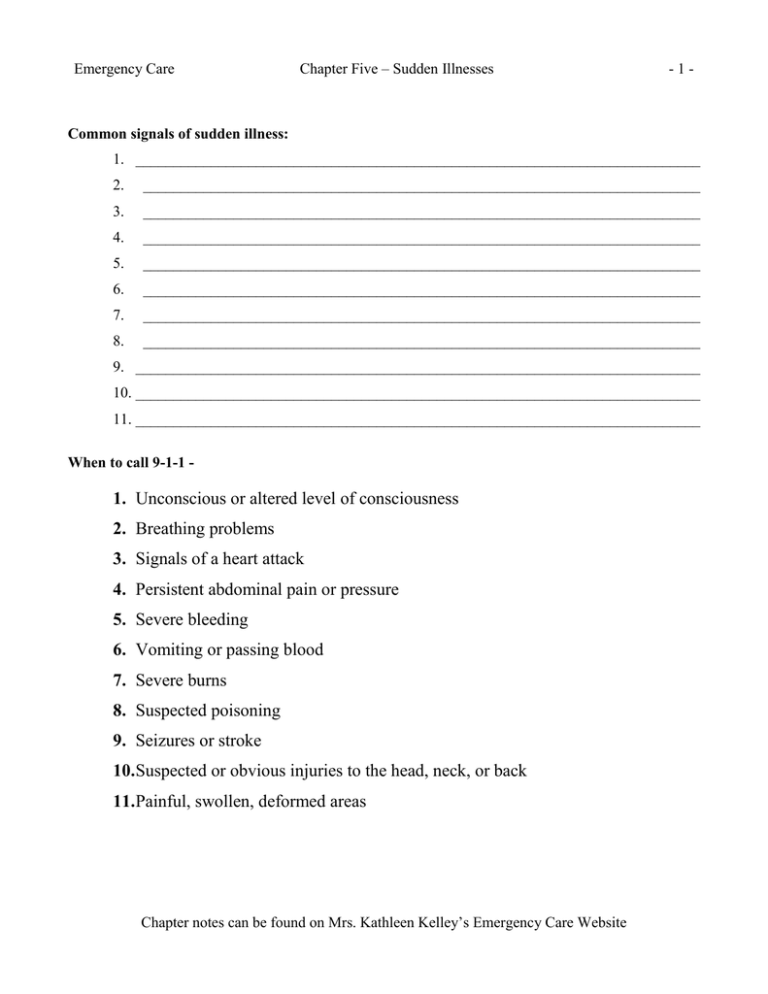
Emergency Care Chapter Five – Sudden Illnesses -1- Common signals of sudden illness: 1. ___________________________________________________________________________ 2. __________________________________________________________________________ 3. __________________________________________________________________________ 4. __________________________________________________________________________ 5. __________________________________________________________________________ 6. __________________________________________________________________________ 7. __________________________________________________________________________ 8. __________________________________________________________________________ 9. ___________________________________________________________________________ 10. ___________________________________________________________________________ 11. ___________________________________________________________________________ When to call 9-1-1 - 1. Unconscious or altered level of consciousness 2. Breathing problems 3. Signals of a heart attack 4. Persistent abdominal pain or pressure 5. Severe bleeding 6. Vomiting or passing blood 7. Severe burns 8. Suspected poisoning 9. Seizures or stroke 10.Suspected or obvious injuries to the head, neck, or back 11.Painful, swollen, deformed areas Chapter notes can be found on Mrs. Kathleen Kelley’s Emergency Care Website Emergency Care Chapter Five – Sudden Illnesses -2- What to do until help arrives 1. ___________________________________________________________________________ 2. ___________________________________________________________________________ 3. ___________________________________________________________________________ 4. ___________________________________________________________________________ 5. ___________________________________________________________________________ 6. ___________________________________________________________________________ 7. ___________________________________________________________________________ 8. ___________________________________________________________________________ 9. ___________________________________________________________________________ Fainting - a partial or complete loss of consciousness resulting from a temporary reduction of blood flow to the brain. Signs and Symptoms 1. __________________________________________________________________________ 2. __________________________________________________________________________ 3. __________________________________________________________________________ 4. __________________________________________________________________________ 5. __________________________________________________________________________ 6. __________________________________________________________________________ Care for Fainting Care Lower the person to the ground Loosen tight clothing Check that the person is breathing Do not give them anything to eat or drink Do not give them anything to eat or drink Call 9-1-1 if you are unsure of the victim’s condition Chapter notes can be found on Mrs. Kathleen Kelley’s Emergency Care Website Emergency Care Chapter Five – Sudden Illnesses -3- Seizures - ___________________________________________________________________________ ____________________________________________________________________________________ ____________________________________________________________________________________ ____________________________________________________________________________________ Signals of a Seizure ____________________________________________________________________________ ____________________________________________________________________________ ____________________________________________________________________________ May experience an ______________, an unusual sensation or feeling, such as ____________________; strange sound, taste or smell; or an urgent need to get to safety Febrile Seizures Most common in children younger than ___________ Often caused by o _____________________________________ o _____________________________________ They most often occur with ____________________________________________ Signals of a febrile seizure 1. 2. 3. 4. 5. Sudden rise in body temperature Change in consciousness Rhythmic jerking of head and limbs Loss of bladder or bowel movements Confusion 6. 7. 8. 9. Crying out Becoming rigid Holding breath Upward rolling of eyes Call 9-1-1 if… The seizure lasts more than five minutes This is their first seizure The person has multiple seizures The person appears to be injured The cause of the seizure is unknown The person is pregnant The person is diabetic The seizure follows a quick rise in temperature The person fails to regain consciousness The seizure takes place in water The person is elderly and could have suffered a stroke The person is a young child or an infant and experienced a febrile seizure brought on by high fever Chapter notes can be found on Mrs. Kathleen Kelley’s Emergency Care Website Emergency Care Chapter Five – Sudden Illnesses -4- Care for Someone Having a Seizure 1. __________________________________________________________________________ 2. __________________________________________________________________________ 3. __________________________________________________________________________ 4. __________________________________________________________________________ 5. __________________________________________________________________________ 6. __________________________________________________________________________ Stroke - also known as a brain attack, a stroke is a disruption of blood flow to a part of the brain which causes permanent damage to brain tissue Mini-stroke - a temporary episode, like a stroke, is caused by a disruption of blood flow to the brain; someone who has a mini stroke is at high risk of having a full blown stroke. Risk Factors for Stroke High Blood Pressure ____________________________________________________________________________________ ____________________________________________________________________________________ Diabetes ____________________________________________________________________________________ ____________________________________________________________________________________ Cigarette Smoking ____________________________________________________________________________________ ____________________________________________________________________________________ Diet ____________________________________________________________________________________ ____________________________________________________________________________________ Preventing Stroke Control your blood pressure Quit smoking Eat a healthy diet Exercise regularly Maintain a healthy weight Control diabetes Chapter notes can be found on Mrs. Kathleen Kelley’s Emergency Care Website Emergency Care Chapter Five – Sudden Illnesses -5- Signals of a Stroke 1. __________________________________________________________________________ 2. __________________________________________________________________________ 3. __________________________________________________________________________ 4. ___________________________________________________________________________ 5. ___________________________________________________________________________ 6. ___________________________________________________________________________ F.A.S.T. F __________________________________________________________________________________ A __________________________________________________________________________________ S __________________________________________________________________________________ T __________________________________________________________________________________ Care for someone having a stroke Note when the symptoms started If they are unconscious – o Make sure their airway is open o Position the victim on their side if they have fluid in their mouth o Stay with the person and monitor their signs of life If they are conscious – o Check for non-life threatening conditions o Reassure the victim o Have the victim rest in a comfortable position o Do not give them anything to eat or drink Chapter notes can be found on Mrs. Kathleen Kelley’s Emergency Care Website Emergency Care Chapter Five – Sudden Illnesses -6- Diabetes - the inability of the body to change sugar from food to energy This can lead to other medical conditions such as blindness, nerve disease, kidney disease, heart disease, and stroke. Types of Diabetes Types I ____________________________________________________________________________________ ____________________________________________________________________________________ Type II ____________________________________________________________________________________ ____________________________________________________________________________________ Types of Diabetic Emergencies Hyperglycemia ____________________________________________________________________________________ ____________________________________________________________________________________ Hypoglycemia ____________________________________________________________________________________ ____________________________________________________________________________________ Signs and Symptoms of a Diabetic Emergency 1. __________________________________________________________________________ 2. __________________________________________________________________________ 3. __________________________________________________________________________ 4. __________________________________________________________________________ 5. ___________________________________________________________________________ 6. ___________________________________________________________________________ Chapter notes can be found on Mrs. Kathleen Kelley’s Emergency Care Website Chapter Five – Sudden Illnesses Emergency Care -7- Care for Diabetic Emergencies If the person is conscious – _________________________________________________________________ ___________________________________________________________ ___________________________________________________________ __________________________________________________________________ If they are unconscious – _________________________________________________________________ _________________________________________________________________ Allergic Reactions Allergic reactions are caused by over activity of the immune system against specific antigens (foreign substances). Antigens that often cause allergic reactions are bee or insect stings, antibiotics, pollen, animal dander, latex, certain foods such as nuts or shellfish. What to Look For ______________________________________________________________________________ ______________________________________________________________________________ ______________________________________________________________________________ ______________________________________________________________________________ ______________________________________________________________________________ ______________________________________________________________________________ ______________________________________________________________________________ ______________________________________________________________________________ ______________________________________________________________________________ Call 9-1-1 if The person has trouble breathing Complains of the throat tightening Explains that he or she is subject to severe allergic reactions If the person is unconscious Chapter notes can be found on Mrs. Kathleen Kelley’s Emergency Care Website Emergency Care Chapter Five – Sudden Illnesses -8- What to do until help arrives Monitor the person’s breathing Give care for life threatening conditions Check a conscious person to determine o The substance (antigen) involved o The route of exposure o The effects of the exposure Assist the person to use an Epi Pen Assist the person to take antihistamine Document any changes in the person’s condition How Poisons Enter the Body A poison is any substance that causes injury, illness, or death if it enters the body. A person can be poisoned by ______________________________________________________________________________ ______________________________________________________________________________ ______________________________________________________________________________ ______________________________________________________________________________ Checking the Scene for Poisoning Check for clues about what happened o ________________________________________________________________________ o ________________________________________________________________________ o ________________________________________________________________________ Try to get information from the victim or bystanders Try to find outo ________________________________________________________________________ o ________________________________________________________________________ o ________________________________________________________________________ o ________________________________________________________________________ Chapter notes can be found on Mrs. Kathleen Kelley’s Emergency Care Website Emergency Care Chapter Five – Sudden Illnesses -9- Signs and Symptoms of Poisoning Nausea, vomiting, and diarrhea Chest or abdominal pain Trouble breathing Sweating Changes in consciousness Headache Dizziness Burning or tearing eyes Burns around the lips, tongue, or on the skin General Care for Poisoning Remove the person from the source of poisonif the scene is dangerous Check the person’s level of consciousness, breathing, and other signs of life Care for any life threatening conditions Gather information Look for containers and take them with you to the phone Call 9-1-1 of the Nation Poison Control Center 1-800-222-1222 Follow the directions given to you by the professionals Poison Control Center PCCs help reduce the workload of the EMS system by helping people deal with poisonings. Many can be found in emergency departments of hospitals. Special Care Considerations Toxic Fumes ____________________________________________________________________________________ ____________________________________________________________________________________ Chemicals ____________________________________________________________________________________ ____________________________________________________________________________________ Preventing Poisonings ______________________________________________________________________________ ______________________________________________________________________________ ______________________________________________________________________________ ______________________________________________________________________________ ______________________________________________________________________________ Chapter notes can be found on Mrs. Kathleen Kelley’s Emergency Care Website



